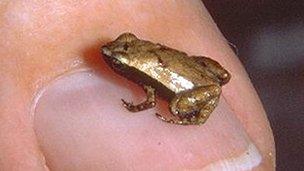Tiny Gardiner's frog listens with its mouth
- Published
Highly sensitive X-ray imaging techniques allowed the researchers' to examine the frog's anatomy in detail
Scientists have discovered how one of the world's smallest frogs is able to hear with its mouth.
The tiny, earless Gardiner's frog was assumed to be deaf.
But this study published in the Proceedings of the National Academy of Sciences, external revealed that it uses its mouth cavity to convey sound signals to its brain.
The discovery solves the mystery of why the earless frog produces loud, high-pitched squeaks.
The diminutive frogs, which live in the forests of the Seychelles, have no middle ear region at all, meaning they have no resonating eardrum.
Researchers had therefore assumed that the animals had no way to amplify and transmit sound waves from the environment into the inner ear and, via nerve cells, to the brain.

The Gardiner's frog is one of the world's smallest
But this research revealed that the species defied those assumptions.
The scientists made recordings of the frogs' calls and played them back to wild frogs in order to observe their behaviour.
Justin Gerlach from the Nature Protection Trust of Seychelles, external and a member of the research team, explained that the frog's call was "one of the characteristic noises in the forest".
"It's a very loud high-pitched squeak," he told BBC News.
The playback experiments showed that the frogs were able to hear these squeaks.
"If you play the call, they respond," explained Dr Gerlach.
"Either they change position - they may move to face where the call is coming from - or quite often they will call in response."
Lead researcher Renaud Boistel from the French National Centre for Scientific Research added: "It's very funny actually; [the frogs would] even attack the loud speaker."
Resonating mouth
The next step was to find out how the frogs were able to hear the sound.
To investigate this, the team used highly sensitive X-ray imaging techniques at the European Synchrotron Research Facility (ESRF), external in Grenoble.
This allowed them to examine the frog's anatomy in fine detail and and work out which body parts might play the role of the middle ear - transmitting sound wave signals via nerves to the brain.
The team produced simulations of how the frog's head responded to sound waves of the same frequency as the frog's high-pitched call. This confirmed that, at those frequencies, the frogs' mouth cavity resonated like the body of a guitar - amplifying the sound.
Gardiner's frogs have also evolved much thinner and fewer layers of tissue between their mouth cavity and inner ear. This allows sound waves to be more effectively transmitted to the "labyrinth" of fluid in the frogs' head and then onto the brain via nerve cells.
Dr Boistel said: "This combination of a [resonating] mouth cavity and bone conduction allows Gardiner's frogs to perceive sound effectively without use of a middle ear."
He added that he hoped the discovery of this novel hearing mechanism could be applied to help certain types of human deafness.
Endangered and isolated
Gardiner's frogs only live in the Seychelles.
"They're cut off on an island in the middle of the Indian Ocean, which makes them one of the most geographically isolated frogs in the world," explained Dr Gerlach. "And they've been isolated there since Seychelles split from Indian 65 million years ago."
The species is listed as endangered, primarily because its habitat is being degraded by fire, invasive species, and human activity including agriculture and tourism.
Dr Gerlach said: "The possible extinction of these frogs would mean the loss of 65 million years of remarkable evolution: not only are their hearing systems unusual, but they are also among the smallest frogs in the world."
Related topics
- Published5 July 2013
- Published8 July 2013
- Published10 July 2013